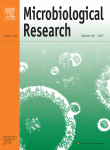Ver ítem
- xmlui.general.dspace_homeCentros e Institutos de InvestigaciónCICVyA. Centro de Investigación en Ciencias Veterinarias y AgronómicasInstituto de BiotecnologíaArtículos científicosxmlui.ArtifactBrowser.ItemViewer.trail
- Inicio
- Centros e Institutos de Investigación
- CICVyA. Centro de Investigación en Ciencias Veterinarias y Agronómicas
- Instituto de Biotecnología
- Artículos científicos
- Ver ítem
Purification and characterization of a GH43 β-xylosidase from Enterobacter sp. identified and cloned from forest soil bacteria
Resumen
The use of lignocellulosic biomass for second generation biofuels requires optimization of enzymatic breakdown of plant cell walls. In this work, cellulolytic bacteria were isolated from a native and two cultivated forest soil samples. Amplification of glycosyl hydrolases was attempted by using a low stringency-degenerate primer PCR strategy, using total soil DNA and bulk DNA pooled from positive colonies as template. A set of primers was designed based
[ver mas...]
The use of lignocellulosic biomass for second generation biofuels requires optimization of enzymatic breakdown of plant cell walls. In this work, cellulolytic bacteria were isolated from a native and two cultivated forest soil samples. Amplification of glycosyl hydrolases was attempted by using a low stringency-degenerate primer PCR strategy, using total soil DNA and bulk DNA pooled from positive colonies as template. A set of primers was designed based on Acidothermus cellulolyticus genome, by search of conserved domains of glycosyl hydrolases (GH) families of interest. Using this approach, a fragment containing an open reading frame (ORF) with 98% identity to a putative GH43 beta-xylosidase coding gene from Enterobacter cloacae was amplified and cloned. The full protein was expressed in Escherichia coli as N-terminal or C-terminal His-tagged fusions and purified under native conditions. Only N-terminal fusion protein, His-Xyl43, presented beta-xylosidase activity. On pNPX, optimal activity was achieved at pH 6 and 40 °C and Km and Kcat values were 2.92 mM and 1.32 seg−1, respectively. Activity was also demonstrated on xylobiose (X2), with Km 17.8 mM and Kcat 380 s−1. These results demonstrated that Xyl43 is a functional beta-xylosidase and it is the first evidence of this activity for Enterobacter sp.
[Cerrar]

Autor
Campos, Eleonora;
Negro Alvarez, María José;
Sabaris Di Lorenzo, Gonzalo Julián;
Gonzalez, Sergio Alberto;
Rorig, Marcela Laura;
Talia, Paola Mónica;
Grasso, Daniel Horacio;
Sáez, Felicia;
Manzanares Secades, Paloma;
Ballesteros Perdices, Mercedes;
Cataldi, Angel Adrian;
Fuente
Microbiological Research 169 (2–3) : 213-220 (February–March 2014)
Fecha
2014-03
Editorial
Elsevier
ISSN
0944-5013
1618-0623
1618-0623
Formato
pdf
Tipo de documento
artículo
Palabras Claves
Derechos de acceso
Abierto
 Excepto donde se diga explicitamente, este item se publica bajo la siguiente descripción: Creative Commons Attribution-NonCommercial-ShareAlike 2.5 Unported (CC BY-NC-SA 2.5)
Excepto donde se diga explicitamente, este item se publica bajo la siguiente descripción: Creative Commons Attribution-NonCommercial-ShareAlike 2.5 Unported (CC BY-NC-SA 2.5)


